Light and Weather
by Michael Frye | Feb 1, 2024 | Light and Weather
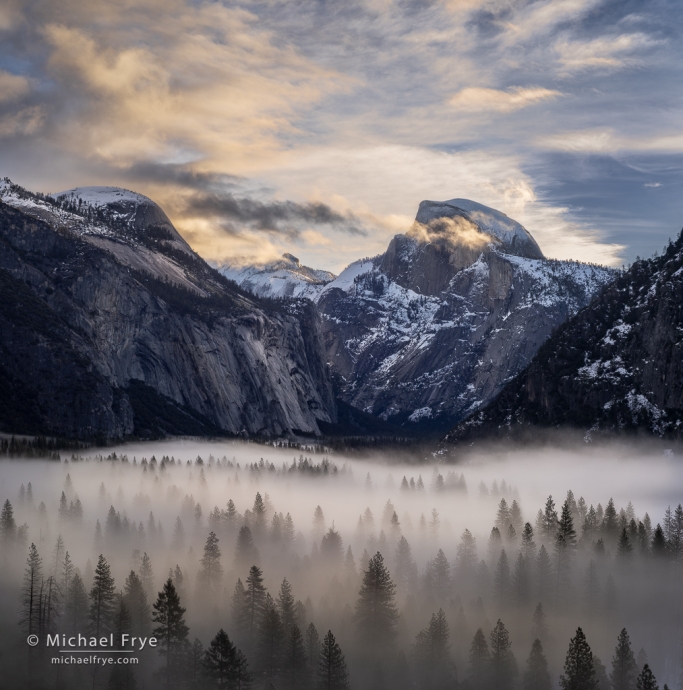
Half Dome above a fog layer at sunrise, Yosemite NP, California. This is actually two frames from my 50mm lens stitched together, as that lens wasn’t quite wide enough, but my next widest lens (35mm) was too wide.
After photographing the trees in fog I described in this recent post, a few mornings later I went up to Yosemite Valley again as another storm was clearing. I climbed up to a different spot, with a view of Half Dome, and once again saw the valley floor covered in a shallow layer of fog, with trees poking out.
But this time I also saw high clouds, and some mist wrapped around Half Dome. Under those conditions the higher clouds often light up before sunrise, but not this time; probably some clouds farther east, out of sight, blocked that early light. But later, as the sun rose higher, it broke through and backlit the clouds and mist. My favorite moment is shown above, with that backlit mist, and trees poking out of the fog below.
(more…)
by Michael Frye | Jan 23, 2024 | Light and Weather
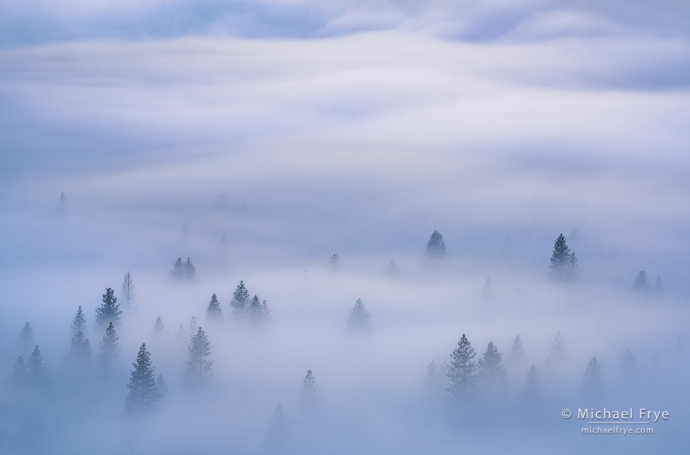
Trees and waves of fog, Yosemite NP, California
On a Sunday morning nine days ago I headed up to Yosemite Valley as a small storm was clearing. This system was on the warm side, so it rained at the valley elevation (around 4,000 feet). But there was still some snow on the ground from previous storms, and rain on top of snow is a fog-generating machine, so I figured there would be lots of fog and mist.
And there was lots of mist when I arrived in the valley. I climbed up to one of my favorite off-the-beaten path viewpoints, thinking to capture a classic Yosemite clearing storm. But when I reached that spot it became apparent that the mist wasn’t wrapping around the cliffs as I’d expected. Instead, I saw a shallow layer of fog covering the length of the Valley floor, with the tops of tall ponderosa pines poking up through the fog layer. Which looked gorgeous.
(more…)
by Michael Frye | Jan 9, 2024 | Light and Weather
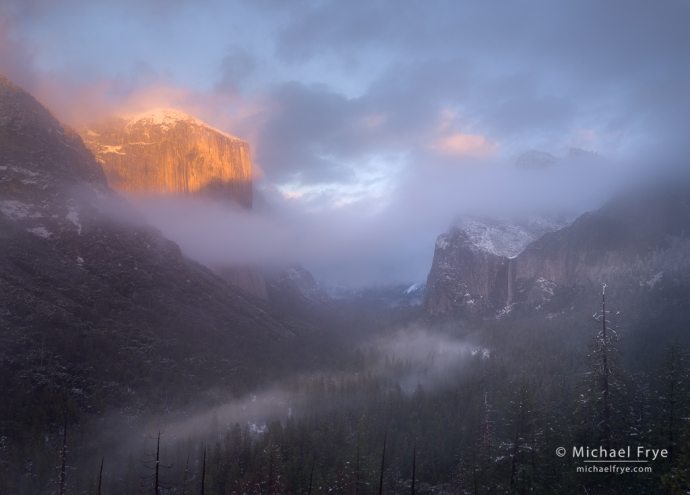
Misty sunset from Tunnel View, Yosemite NP, California
Last Tuesday night a small snowstorm moved through Yosemite. It’s been a dry winter so far, and this was the first significant snow in Yosemite Valley in quite awhile. It also looked like the storm might clear around sunrise, which was good timing.
So Claudia and I rose early Wednesday morning and drove up to the Valley, where we found about four inches of new snow. It was great to see the trees decked out in white, and to feel the snow underfoot.
(more…)
by Michael Frye | Dec 20, 2023 | Composition, Light and Weather
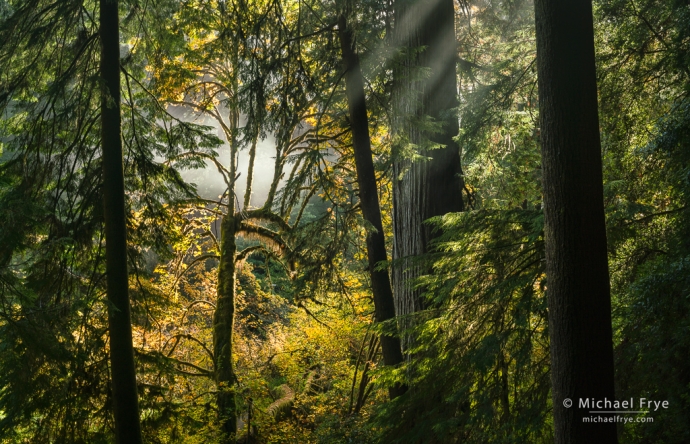
Redwood, maple, firs, and sunbeams, northern California
We had a long, lingering autumn here on the west coast – especially in the Pacific Northwest. On our way up to Oregon in early November, Claudia and I stopped in some redwood groves to check on the fall color. And we found lots of it. It seemed like a good year for color throughout the Northwest, including the far northern corner of California where the biggest redwoods grow. Underneath the redwood canopy, vine maples and big-leaf maples – the same species found on the Olympic Peninsula, and throughout much of Oregon and Washington – can add splashes of color to the forest.
I had long wanted to photograph fall color in the redwoods, but it’s difficult to find the right conditions, especially since the best groves are a nine-hour drive from home. Some years the big-leaf maples just turn brown. And even if they do turn yellow the timing is highly variable. So we felt very lucky to find some good color this year.
(more…)
by Michael Frye | Aug 29, 2023 | Light and Weather, Yosemite Photo Conditions
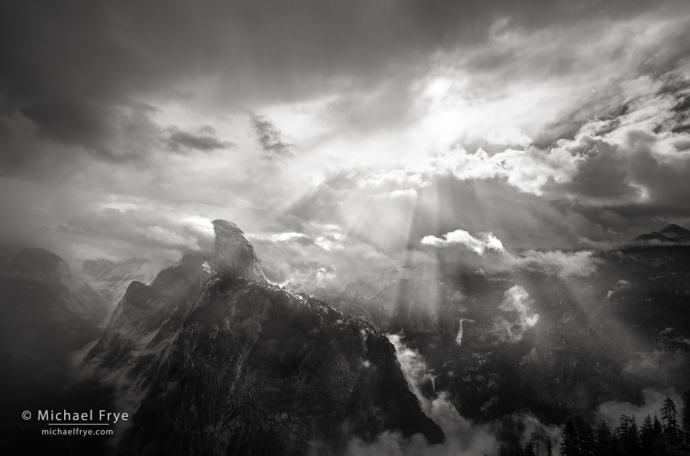
Sunbeams, Half Dome, and Nevada Fall from Glacier Point, Yosemite NP, California
As the remnants of Tropical Storm Hilary moved through California, I looked for opportunities to photograph interesting weather. I thought we might get thunderstorms, which we did, especially as the first bands of moisture reached our area. But I wasn’t able to find a thunderstorm in the right position to photograph it. We did, however, get three-quarters of an inch of rain at our house from one thunderstorm.
Then, as this large weather system moved off to the north, I realized there might be a chance to photograph a clearing storm Monday morning (August 21st). It looked like the rain would end around sunrise in Yosemite; it was less clear whether the clouds would dissipate enough for the sun to break through that early.
(more…)
by Michael Frye | Aug 20, 2023 | Light and Weather, Travels and Stories
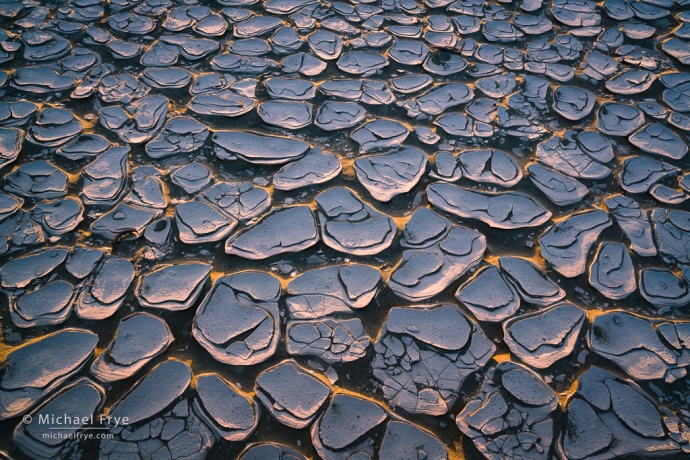
Mud tiles in late-afternoon light, Death Valley NP, California
I’m thinking about Death Valley, and other desert areas in California currently affected by the rain from Tropical Storm Hilary. These are places that receive very little precipitation, where the ground is mostly rock and dirt, and even a half-inch of rain can fill normally-dry washes and create flooding and debris flows. There are few bridges along the roads in the desert; they just run right through the washes, because it’s so rare for those washes to have any water in them. That means even minor flooding or debris flows can cause lots of damage.
This storm could bring several inches of rain to many desert areas today and tomorrow. Some places could get a year’s worth of precipitation, or several year’s worth, in just a couple of days, or even a few hours. It’s a scenario that could cause major rock and mudslides, wipe out roadways, and create catastrophic flash floods. I hope everyone in those areas has found a safe place to ride out the storm.
(more…)














